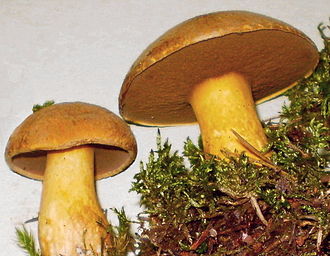Suillus variegatus
Suillus variegatus, commonly known as the variegated bolete, is a species of mushroom belonging to the genus Suillus within the family Suillaceae. It is a mycorrhizal fungus, forming symbiotic associations with the roots of pine trees, which is crucial for nutrient exchange between the soil and the tree. This species is found across various parts of Europe and Asia, where pine forests are prevalent.
Description
Suillus variegatus mushrooms have a distinctive appearance that makes them relatively easy to identify. The cap, which can range from 5 to 15 cm in diameter, typically has a sticky surface when wet and is colored in various shades of brown with a variegated or mottled pattern. The stipe (stem) is also brown, often lighter than the cap, and may feature small dots or scales. The pores on the underside of the cap are small and round, initially yellow before turning olive-brown with age. Unlike many other bolete species, Suillus variegatus does not bruise blue when handled or cut.
Habitat and Distribution
Suillus variegatus is predominantly found in coniferous forests, especially those dominated by various species of pine (Pinus spp.). It forms ectomycorrhizal relationships with these trees, facilitating the exchange of nutrients between the fungus and its host. This species is widespread in Europe and Asia, reflecting the distribution of its pine hosts.
Ecology
As a mycorrhizal fungus, Suillus variegatus plays a significant role in forest ecosystems. It helps in the decomposition of organic matter, thereby contributing to the nutrient cycle. Additionally, by forming a symbiotic relationship with pine trees, it enhances the growth and health of the forest. This species is also part of the diet of various forest animals, including insects and small mammals, which may help in spore dispersal.
Culinary and Medicinal Use
While Suillus variegatus is considered edible, it is not highly regarded in comparison to other boletes due to its slimy cap and the potential for mild gastrointestinal upset in some individuals. If consumed, it is recommended to remove the slimy cap skin and to cook the mushroom thoroughly. There is no significant medicinal use of this species reported in traditional or modern medicine.
Conservation
Currently, there are no major conservation concerns for Suillus variegatus, as it is relatively widespread and common where suitable habitat exists. However, like all fungi, its populations are susceptible to changes in forest management practices, pollution, and climate change, which could impact its mycorrhizal relationships and, consequently, forest health.
Transform your life with W8MD's budget GLP-1 injections from $125.
W8MD offers a medical weight loss program to lose weight in Philadelphia. Our physician-supervised medical weight loss provides:
- Most insurances accepted or discounted self-pay rates. We will obtain insurance prior authorizations if needed.
- Generic GLP1 weight loss injections from $125 for the starting dose.
- Also offer prescription weight loss medications including Phentermine, Qsymia, Diethylpropion, Contrave etc.
NYC weight loss doctor appointments
Start your NYC weight loss journey today at our NYC medical weight loss and Philadelphia medical weight loss clinics.
- Call 718-946-5500 to lose weight in NYC or for medical weight loss in Philadelphia 215-676-2334.
- Tags:NYC medical weight loss, Philadelphia lose weight Zepbound NYC, Budget GLP1 weight loss injections, Wegovy Philadelphia, Wegovy NYC, Philadelphia medical weight loss, Brookly weight loss and Wegovy NYC
|
WikiMD's Wellness Encyclopedia |
| Let Food Be Thy Medicine Medicine Thy Food - Hippocrates |
Medical Disclaimer: WikiMD is not a substitute for professional medical advice. The information on WikiMD is provided as an information resource only, may be incorrect, outdated or misleading, and is not to be used or relied on for any diagnostic or treatment purposes. Please consult your health care provider before making any healthcare decisions or for guidance about a specific medical condition. WikiMD expressly disclaims responsibility, and shall have no liability, for any damages, loss, injury, or liability whatsoever suffered as a result of your reliance on the information contained in this site. By visiting this site you agree to the foregoing terms and conditions, which may from time to time be changed or supplemented by WikiMD. If you do not agree to the foregoing terms and conditions, you should not enter or use this site. See full disclaimer.
Credits:Most images are courtesy of Wikimedia commons, and templates, categories Wikipedia, licensed under CC BY SA or similar.
Contributors: Prab R. Tumpati, MD

